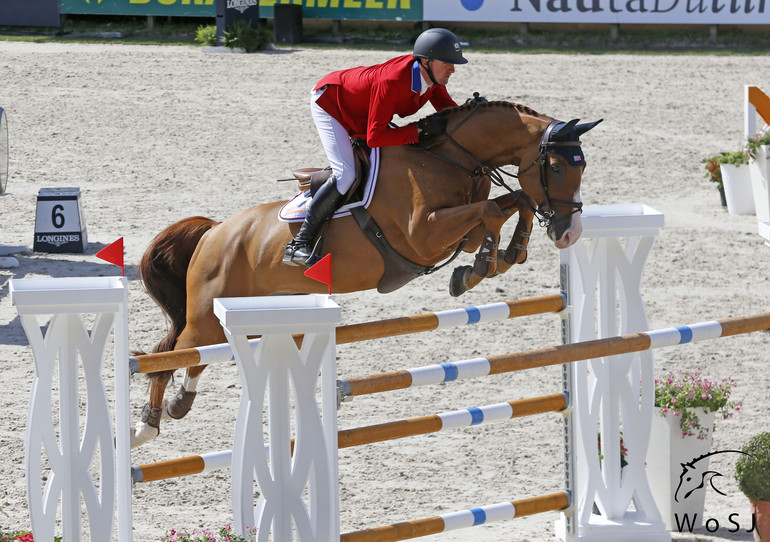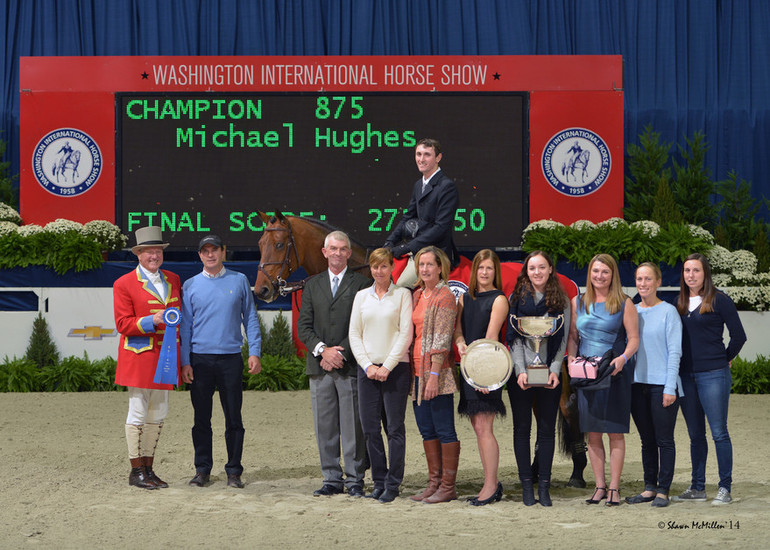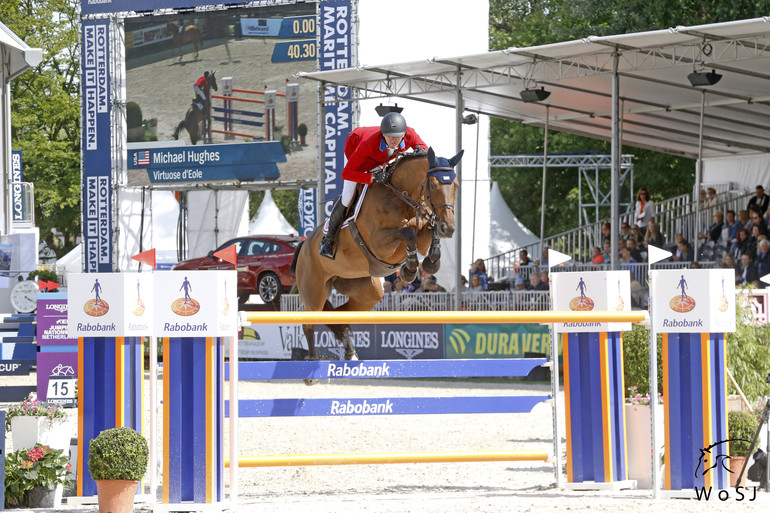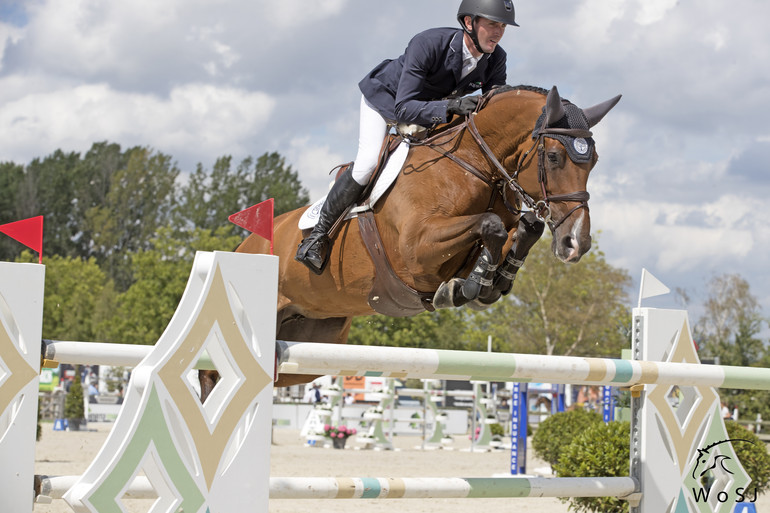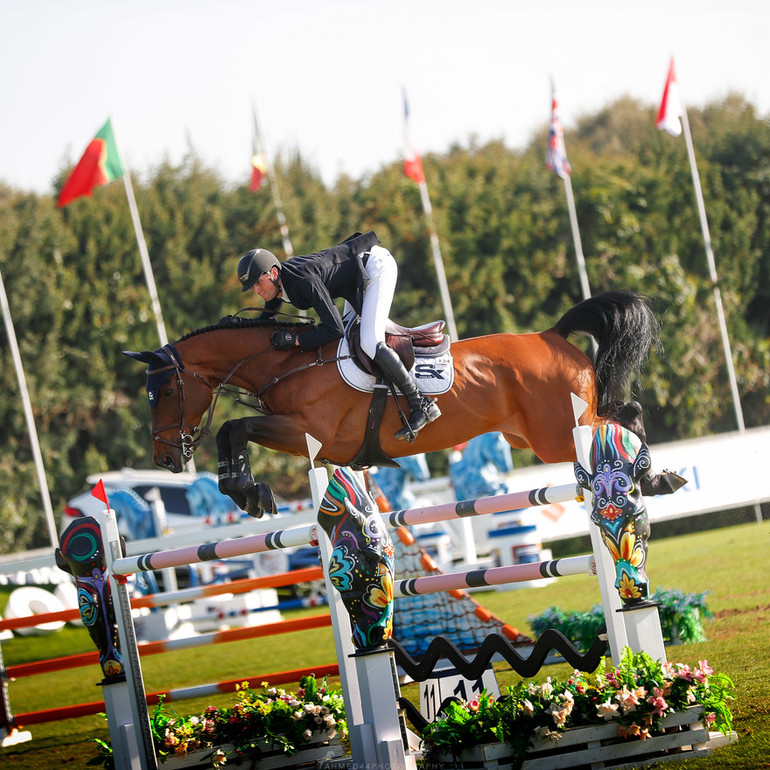Text © World of Showjumping
Before he had reached 20, Michael Hughes had already built up a name for himself on the American equitation and showjumping circuit. In 2013, at the age of 17, Michael won the USEF Show Jumping Talent Search Finals East, and the year after he topped the WIHS Equitation Finals as well as claiming individual silver at the North American Young Rider Championships – all leading to the USET Foundation awarding him with the prestigious Maxine Beard Show Jumping Rider Award in 2015.
Michael started riding at the age of three and made his first jumps shortly after. Under the watchful eye of his parents Cathy and Eamonn Hughes, who ran a small dealing stable, Michael quickly made progress on the horse back. Already when he was 13, The Chronicle of the Horse reported that Michael had taken the show circuit by storm “leaving spectators and trainers enamoured by the natural style and poise of such a young rider.”
From his parents, Michael got a solid education – which was further strengthened by North Run’s Missy Clark. “I rode with Missy for eight years. She helped me in the equitation and a bit in the jumpers,” Michael tells.
“I always had a lot of different horses to ride and there were constantly horses coming in and out of our stable,” Michael tells about the beginning of his career. “When I was a junior, I was also very fortunate that I had a lot of catch rides. Being used to having a bunch of different horses to ride has certainly been of benefit later on.”
Leaving no stones unturned at North Run
In 2016, Michael spent six months working at North Run. “One thing that I really learned during my time at North Run is the importance of preparations,” Michael tells. “Missy never left any stones unturned ahead of an important class; you really went in the ring feeling that you and your horse were so ready – you felt confident that you could win. With the equitation as an example, Missy would have me practice on so many different courses and lines – and on so many different horses. This was really helpful once you came to the show; you never knew what you were going to get asked, but you felt so prepared for whatever was thrown at you.”
“In general, I have had a lot of benefits from my equitation years – whether it comes to reading lines or dealing with pressure,” Michael continues. “For sure, over here in Europe a lot of people would say equitation looks so easy as you just jump all these little fences, but it actually teaches you to deal with nerves at a young age – especially if you ride the finals. And nerves are the same, whether it’s the second round for the equitation finals or the second round in a Nations Cup where you have to jump clear.”
“While I was at North Run, I also learned managing a lot of horses because it is a huge operation there,” Michael explains. “It was incredible to see how many horses they would bring to the shows, and how well organised they still managed to keep everything. Experiencing this has really helped me,” Michael tells.
After having cemented such a solid foundation for himself in the US, Michael wanted more of a challenge and a more diverse experience. “I thought it would be nice to do something different and I wanted to try out Europe,” Michael tells about his decision to leave the US in the fall of 2016. “In America, the shows were mainly the same, there was not much new happening whereas in Europe the choice is completely different. I have been here for five years now, and there is still so much I haven’t experienced and seen. There is always something new.”
Learning from Lansink at Ashford Farm
It was McLain Ward – a friend of the Hughes-family – that connected Michael with Enda Carroll, who runs Ashford Farm in Bocholt, Belgium. “I quickly settled in,” Michael tells about his arrival at Ashford. “We were like one big family there, which made the move a bit easier. There are also a lot of American riders based in that area, and during the summer season many come over from the States. Perhaps, if I had not gone to Ashford first, it would have been different for me. In terms of transitions, the biggest one was probably just working for someone else, because I was used to being with my parents – and it was just all of us doing it together.”
“What I really learned during my time at Ashford Farm is the importance of good flatwork. I quickly discovered that with the horses there, I was not going to be the last person riding them – they were all there to be sold, so rideability was key,” Michael explains. “This was quite different coming straight from America, where it had been more about what was going on in the ring – about what to do and not to do.”
“I was very lucky at Ashford, because I got a lot of help from Jos Lansink with my dressage work,” Michael continues. “In general, the focus was on details that I had not really paid that much attention to before, and it was really helpful for my performances in the ring. With Jos, I did a lot of collective and slow work, also over poles and small jumps – making sure the horses could hold their shape over the fences.”
“What was also really nice at a trading stable such as Ashford was to see top riders come to try the horses, because I could often observe what they did better and what I could improve – and then work from that,” Michael adds.
“In Europe, there is more focus on the flatwork than in the US. I think that this mainly is due to the education of all the young horses that takes place here,” Michael says. “At Ashford we mostly got the horses when they were 5, 6 and 7 years old so you really had to think about their flatwork to get them to ride better. It was always more focus on the flatwork than the jumping – before a show we would only jump small fences. All the dressage work makes a big difference in the ring, because everything feels and looks so much easier.”
“When I went to Ashford, I was not meant to be the main rider there – but I kept on working hard and I got more opportunities. Enda was really great like that; he really appreciates someone who works hard,” Michael tells about how he established a name for himself on the European circuit – making his five-star CSIO debut in 2018. “My normal workday at Ashford would be to start at 7 AM and then keep on riding throughout the day. I normally never rode more than eight horses though; Enda was of the opinion that if the riders had more on the list, the horses would not be given the necessary time – he wanted to make sure we put enough effort into them.”
Keeping it simple at Oakland Stables
After three years at Ashford Farm, Michael moved on to work for one of the world’s best riders – Darragh Kenny. Just like Michael, Darragh spent the early days of his international career at North Run with Missy Clark. Today, the Irish rider runs his own trading and training business Oakland Stables with operations both in Europe and the US. “The system at Oakland was a lot more American compared to what I had experienced at Ashford,” Michael tells. “Another big difference was that Darragh was extremely busy; he was normally at a show somewhere nearly every week, so I was mostly on my own. Whereas Enda had been very involved in almost everything I did, Darragh got involved as often as he was at home.”
“At Oakland, I most of the time only had to focus on the ten horses I had on my list. However, when Darragh left for Florida I also had to train some of the clients that were here in Europe,” Michael tells. “That was something new for me. It is totally different having to organise your own horses and somebody else’s, so it took me a bit of time to get used to it. I really liked it though. Training is certainly something I would consider doing in the future, but as a rider you need to have the time for it.”
“What was really amazing to see working for a top rider like Darragh, is how simple he kept everything – even with his best horses,” Michael tells. “The horses did not do all that much, just a bit of flatwork and hacking out. Then Darragh himself would perhaps do some small jumps with them before they left for the show, but that was it. Darragh had two fantastic grooms, who were so meticulous about everything – that was amazing to observe,” Michael tells.
“Darragh is a very good teacher, but actually the best part was when he would get on the horses and show you,” Michael tells. “You can say something as much as you want, but it might not look like that – so it was really nice when Darragh would get on and say: ‘I don’t know what you are feeling’, or: ‘Oh, now I get it’.”
Working independent among the stars at Stephex Stables
In August last year, Michael started working at Stephex Stables – one of the largest trading stables in Europe. “It has been a bit different compared to what I was used to,” Michael tells. “I have a lot more independence, but also more responsibilities. At Stephex, all the riders deal with their own horses and their own team.”
“All the riders at Stephex work separately, but it’s still a great opportunity to see how Daniel [Deusser] and Lorenzo [De Luca] are doing things,” Michael tells. “It’s amazing to get to watch them every day, and if I need help, I can always ask. It’s also nice to work in a place where everyone is so motivated for the stables to be the best that it can be – whether you want to build up youngsters, focus on the sales or to be competitive at shows. Stephan always wants the best horses for his riders and has goals for everyone to do well.”
“At the moment it’s really busy, and I have a lot of horses on my list,” Michael tells. “I have a show groom, a home groom and a flat rider on my team to help me though – so it is a bit like having my own stable, which is really nice.”
“Working in a place like Stephex, you never know what can happen,” Michael smiles. “There are so many horses and so many riders, and a horse that might not work for one of the other riders could actually be my best horse. This is why I believe in taking every opportunity I can get; with whatever horse it is – because I have experienced before that horses that don’t go well for others can go well for me and vice versa.”
“If I get a horse that did not necessarily work that well with its previous rider, I first ride it a couple of times to see what I feel. Then I would always try to figure out what worked for the previous rider and what didn’t. I watch a bunch of rounds – good and less good rounds, study which bridles the horse was on – I am very bridle obsessed! I think taking time to understand the horse, speaking with the previous rider and being open to do different things – not just do it your way – is really important,” Michael explains. “As is adapting to the horses. You can have your own system, but you also need to be able to change it for each horse you are working with because there is not one thing that will work for all of them.”
“If a horse does not work well for me, I have learned to stay positive through it all. If it goes to another rider, you just can’t take it personal. Not all horses go the best for everybody, and you have to accept that you can’t ride all horses in the world,” Michael continues.
“Personally I enjoy a bit of a challenge – I like a horse that has been difficult for its past riders. Then I will try my best to make sure that it goes well for me!” Michael concludes with a smile.
No reproduction without written permission, copyright © World of Showjumping.com



